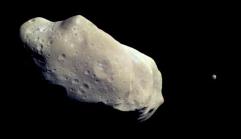
 |
| Our subscribers' grade-level estimate for this page: 4th |
| Table of Contents | Enchanted Learning All About Astronomy |
Site Index |
| Our Solar System | Stars | Glossary | Printables, Worksheets, and Activities | ||||||
| The Sun | The Planets | The Moon | Asteroids | Kuiper Belt | Comets | Meteors | Astronomers | ||
| ASTEROIDS |
| Introduction | Near-Earth Asteroids (NEA) |
Asteroids and Dinosaurs | List of Some Asteroids | Composition | Activities, Web Links |
|---|
| Asteroids |
Asteroid 253 Mathilde, a Near-Earth Asteroid photographed by NASA's NEAR (Near Earth Asteroid Rendezvous) mission in June 1997. Mathilde is about 60 km in diameter and orbits in the asteroid belt between Mars and Jupiter. |
Gaspra, Asteroid #951. |
Asteroid 4 Vesta, the brightest asteroid and the fourth largest. Vesta is the only asteroid that can be seen without a telescope (it is sixth magnitude). |
 The asteroid 243 Ida and its tiny asteroid moon, Dactyl. This is the first asteroid ever found with an orbiting moon. Ida's dimensions are about 56 x 24 x 21 kilometers (35 x 15 x 13 miles). Dactyl is only about 1.2 x 1.4 x 1.6 km (0.75 x 0.87 x 1 mile) across. |
TROJAN ASTEROIDS
Trojan asteroids are asteroids that orbit in gravitationally stable Lagrange points in a planet's orbit, either trailing it or preceding it (these places are where the gravitational attraction of the Sun and of the planet balance each other). Jupiter has the most Trojan asteroids; Mars also has some. Achilles was the first Trojan asteroid found. The asteroids preceding Jupiter in its orbit were named for Greek heroes; those following Jupiter in its orbit were named for Trojan heroes.
ASTEROID ACTIVITIES
Asteroid coloring page
An interactive puzzle about asteroids
Asteroids Cloze: A fill-in-the-blanks activity on asteroids. Answers
Enchanted Learning®
Over 35,000 Web Pages
Sample Pages for Prospective Subscribers, or click below
|
Overview of Site What's New Enchanted Learning Home Monthly Activity Calendar Books to Print Site Index K-3 Crafts K-3 Themes Little Explorers Picture dictionary PreK/K Activities Rebus Rhymes Stories Writing Cloze Activities Essay Topics Newspaper Writing Activities Parts of Speech Fiction The Test of Time
|
Biology Animal Printouts Biology Label Printouts Biomes Birds Butterflies Dinosaurs Food Chain Human Anatomy Mammals Plants Rainforests Sharks Whales Physical Sciences: K-12 Astronomy The Earth Geology Hurricanes Landforms Oceans Tsunami Volcano |
Languages Dutch French German Italian Japanese (Romaji) Portuguese Spanish Swedish Geography/History Explorers Flags Geography Inventors US History Other Topics Art and Artists Calendars College Finder Crafts Graphic Organizers Label Me! Printouts Math Music Word Wheels |
Click to read our Privacy Policy
| Search the Enchanted Learning website for: |